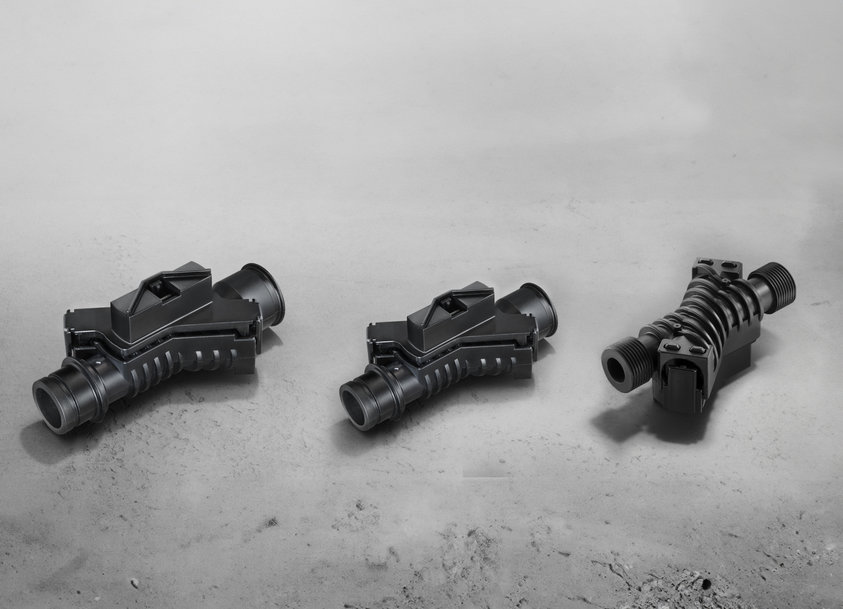www.ptreview.co.uk
08
'24
Written on Modified on
Marquardt News
Energy Efficiency Reduces Costs for HVAC Systems
Marquardt is Expanding its Product Family of Flow Sensors with Ultrasonic Technology.
www.marquardt.com

In heating and cooling systems, the flow of heat transfer fluids is one of the most important variables. Only the continuous monitoring and precise control of the fluid transport ensures efficient operation of the systems and thus saves energy and costs. For this purpose, Marquardt has developed the Ultrasonic Flow Sensor (US Flow Sensor for short), which measures the flow using ultrasonic waves. In addition to the proven standard solution with a diameter of 20 millimeters (mm), which is suitable for many air-water heat pumps, the mechatronics expert is now offering further variants: a smaller version with a diameter of 14 mm, which can be used to equip gas boilers, for example, and a larger 25 mm variant for use in large heat pumps.
Lower Operating Costs through Contactless Signal Detection
In the wake of the energy transition and rising prices for gas and electricity, the demand for modern, energy-efficient heating and cooling systems will continue to grow in the coming years. Regulating the flow of aqueous media is a crucial factor for the smooth and efficient operation of the systems. While conventional flow sensors use mechanical impellers that slow down the flow and can become clogged or even blocked by particles, the US Flow Sensor works without contact using ultrasonic signals. The ceramic piezo disks convert voltages into acoustic signals, and the signal runtime in the water then provides a conclusion to the current flow rate.
This takes the quality of the flow measurement to a new level. Unlike mechanical systems, the US Flow Sensor bypasses restrictions such as pressure drops or resistances in the fluid circuit. This means that the sensor can measure the flow rate much more accurately, thereby optimizing the energy consumption of the heating or cooling system. Marquardt's ultrasonic sensor technology not only works more efficiently than conventional flow sensors, it also reduces energy consumption, maintenance requirements and wear, which in turn lowers operating costs.
Can Be Used in Heat Pumps or Fuel Cells
While the mechanical sensor, which Marquardt also offers, is designed for simpler applications, the US Flow Sensor can best play to its strengths when the control-related functional scope is important. The US Flow Sensor can be used wherever aqueous media are pumped and monitored in complex and sensitive systems. These are often water circuits of air-water heat pumps or coolant paths of fuel cells. The standard variant with a diameter of 20 mm (DN20) is usually sufficient for most applications. With the new variants, which have diameters of 14 (DN14) and 25 mm (DN25), Marquardt is expanding the product family and also the range of applications, for example, when higher or lower flow rates are required. Regardless of the diameter, the geometry of the scalable overall system remains unchanged.
Intelligent Control with a Wide Range of Functions
The new technology has also expanded the range of functions compared to conventional systems. For example, the US Flow Sensor measures the flow rate (volume per time) and temperature of liquid media at the same time. Temperature fluctuations are automatically compensated to ensure precise measurement. In addition, the sensor detects irregularities, such as whether the flow comes to a standstill or even runs in the wrong direction. Impurities or air bubbles, which in mechanical systems can falsify the measurement result or impair efficiency, are also detected. The antifreeze concentration, for example the glycol content in a heat pump circuit, can also be monitored with the help of the US Flow Sensor up to a mixing ratio of 50:50. The sensor is also equipped with numerous digital features that generate real-time data on heating behavior or information for preventive maintenance. Remote diagnostics are also possible via communication interfaces.
In-House Flow Laboratory
To ensure the high quality standard of its ultrasonic sensors, Marquardt operates its own flow laboratory at its headquarter in Rietheim-Weilheim for the development, simulation and optimization of its products. In addition to conducting functional tests, the sensors are pre-calibrated and programmed to customer specifications there.
To find out how Marquardt's ultrasonic flow sensors increase the efficiency of water-to-air heat pumps, read our white paper via the following link.
www.marquardt.com

